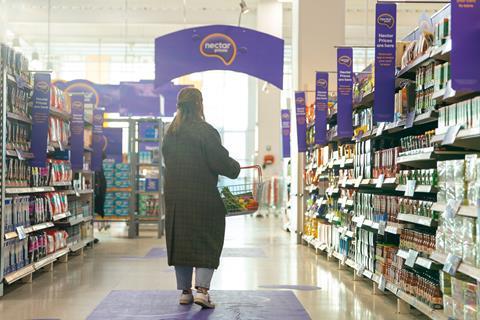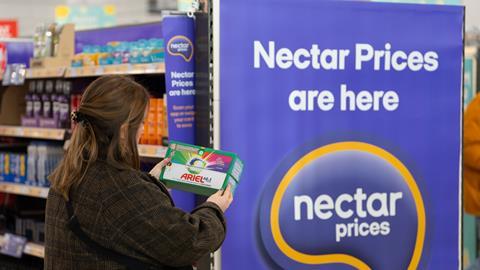As Sainsbury’s and Co-op ape Tesco’s Clubcard Prices model, supermarkets are able to make more on consumer data. But are there risks?
There were balloons, music, even a Shirley Bassey tribute (“Hey big saver”). It was a notable fanfare for the launch last week of Sainsbury’s Nectar Prices, which offers shoppers big discounts if they join its invigorated membership programme.
Co-op’s launch of its own such scheme this Wednesday was rather more muted. But two new schemes in the space of just two weeks is indicative of how retailers are increasingly leveraging their membership (formerly called loyalty) schemes.
The trend of giving members special discounts – led by Tesco and Boots in the UK – is a marked shift from the days when shoppers simply collected points in exchange for rewards. But not without just cause. Around nine in 10 Brits now belong to at least one loyalty scheme, and the majority of them want discounts. New research released this week by loyalty scheme experts Eagle Eye found 63% of Brits want discounts from their loyalty schemes, compared with just 20% who want points, miles or other such rewards.
Some retailers are behind on this trend. Eagle Eye surveyed over 1,300 consumers and nearly 200 loyalty programme managers, finding that in spite of shopper demand, only 39% of retailers plan to offer more discounts on a wider range of items this year, while more than half are going to make it easier to earn and redeem points.
Tesco’s Clubcard is arguably showing the success discount schemes can have (notwithstanding that it may have to find a new logo, after losing a High Court trademark infringement battle this week to Lidl). After rocky beginnings, a number of relaunches and the introduction of Clubcard Prices in 2019, Tesco’s annual results last week showed 79% of its UK shoppers are now signed up, after a year in which the number of promotions grew by 10%.
Points risk
Tesco is clearly favouring in-store discounts over points. Over the past five years, it has halved the value of its points scheme, which customers can exchange at spots like Pizza Express and Zizzi, even in the face of media ire from the likes of money guru Martin Lewis.
That is a risk, say some analysts, who suggest it is deprioritising saying ‘thank you’ to shoppers. “The ability to turn points into, say, a day at Thorpe Park is incredibly meaningful for lots of less affluent shoppers,” says IGD global insights leader Bryan Roberts. “The fact you now have to work a lot harder to achieve some of these rewards is a dilution of that.”
Among younger customers, though, the desire to save money commonly trumps such rewards. Some 43% of gen Z shoppers surveyed by Eagle Eye said they had joined new loyalty schemes to save money, versus just 17% of baby boomers, who more often saved money through buying own label or finding other promotions.
Clubcard’s decision to scale down its points rewards is a reflection of this trend. “Tesco has clearly worked out that Clubcard Prices is a better way of encouraging people to spend more in store than the loyalty element of saving up for vouchers,” says PwC senior retail advisor Kien Tan.

And with more and more retailers now moving in this direction, Clubcard is ahead of the curve. Tesco has incorporated all its promotions into Clubcard, which now covers 5,979 different products.
Sainsbury’s and Co-op therefore have some catching up to do, given Nectar Prices launched with just 446 items. “It’s a bit underwhelming,” says Tan, pointing to both Sainsbury’s limited range and the absence of any deals on fresh, frozen or own label.
While its scope might be small, Sainsbury’s has opened with some eye-catching promotions and offers like half-price Nescafé and Kit Kats, which will no doubt lure many shoppers. In many cases, however, this involves a rebranding of old offers, with more than half of Nectar Prices lines coming off promotion in the month prior to the scheme’s introduction, according to The Grocer’s analysis of Assosia data. That means that to some extent, Sainsbury’s is simply swapping one type of promotion (available to all) for another (for members only).
Read more:
-
Like the Red Bull F1 car, Tesco Clubcard now has an even faster model
-
Co-op to offer lower prices to loyalty card holders
-
Sainsbury’s new Nectar Prices bank on the smug schadenfreude of Tesco’s Clubcard
-
3 trends fmcg brands should watch in 2023
-
Sainsbury’s comes in cheapest even without Nectar Prices
Lucrative data
Yet few experts doubt Sainsbury’s will hit a winning formula eventually. Prior to its launch last week it had only trialled the scheme for 12 weeks across 15 stores in Wales, while Tesco’s scheme has benefited from years of refining.
“Clubcard Prices started out pretty badly,” says Roberts. “The launch was a couple of dozen items and really random stuff like barbecues and coffee jars. It was hugely unconvincing.”
When the stakes are so high, there is plenty of impetus to get it right. After all, these schemes are not just about encouraging purchasing, but developing an entirely separate revenue stream altogether. This comes from customer data and has opened up lucrative advertising opportunities. Sainsbury’s chief marketing officer Mark Given calls it “the hidden profit stream for many big retailers”.

It’s an enviable business model. Supermarkets harvest customer data through promotions funded by their suppliers. This boosts income through enhanced sales, while simultaneously allowing supermarkets to monetise the data by selling it back to the suppliers who effectively funded its capture in the first place. And as one manufacturer points out this week, from a brand point of view, it only really works if you follow through the entire funnel, buying the data back and using it to help target certain shoppers. “If not, you’ve funded the promotions for no insight.”
The public, too, is often aware of what retailers are after, says Roberts. “Shoppers are very happy with Clubcard Prices, but a number of them are aware it’s a trade-off. They’re aware that Tesco is also getting something out of this, largely from a data point of view.”
As one shopper told IGD: “I am giving you my data and you are giving me a cheaper price than if I wasn’t giving you my data… I accept that because I want the price.” It’s a trade-off many, right now at least, seem happy to accept.




















No comments yet